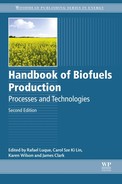10.10. Conclusions and future trends
AD is a well-established, reliable and successful technology implemented worldwide. In the past, anaerobic systems required high capital costs and elaborate expertise to operate and maintain with low process efficiencies. However, in the last decade, the deployment of successful operating systems has increased the technical reliability of anaerobic digesters, reducing the requirements for maintenance and special operative skills. Moreover, many national and regional programs have been designed to cost-share in the development of anaerobic systems and promote the energy policies expanding the renewable energy markets. The EU policy has set a goal of supplying 20% of European energy demands from renewable energy sources by 2020. The major sources for conversion to gaseous, liquid and solid biofuels will be from farming and forestry. At least 25% of the total bioenergy may come from biogas produced from wet organic materials such as animal manure, crop silages, wet organic food, and feed residues, etc. There is also a growing interest in the AD of the organic fraction of the municipal solid waste in an attempt to reduce the materials flow to landfills. Apart from the biogas production benefits, AD offers opportunities for enhanced recycling of organics and nutrients. Codigestion of organically derived municipal waste with sewage sludge, manure, and a range of food processing and other industrial organic wastes is also promising, as it may result in producing more nutrient-balanced fertilizers. A significant category of lignocellulosic feedstock (primarily crops residues) has also been considered to be exploited through AD schemes. There are several pretreatment methods developed that would allow the enhancement of the rate-limiting hydrolysis for the solubilization of the particulate substrates.
Practices promoting the biogas technology may also include dissemination of know-how to all countries worldwide, as well as further research and development on: (1) small-scale systems (to go from the economy of scale to the economy of numbers); (2) process optimization through efficient process control that would strike a balance between the often conflicting targets of biogas maximization and waste stabilization; (3) pretreatment for enhancing the process performance; (4) post-treatment (for further valorization of all byproducts and reduction of the transportation costs); (5) molecular and microbiological level that would give a better insight to the process; (6) reduction of capital and management costs; and (7) more effective elimination of odors to minimize negative social impacts.
..................Content has been hidden....................
You can't read the all page of ebook, please click here login for view all page.
